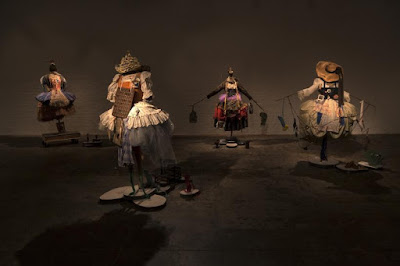ART REVIEW: Suzanne Bocanegra: Poorly Watched Girls
Laura Mulvey is best known for her essay describing the phenomenon of the ‘male gaze,’ where the act of looking in visual media is coded as male, or specifically for heterosexual male viewers, leaving women as passive objects that are meant to be looked at and desired. While not directly referencing Mulvey, Suzanne Bocanegra investigates this concept of women as the target of the gaze in ‘Poorly Watched Girls,’ using multiple media to question whether the performance of watching women can ever truly be enough to understand them as subjects in their own right. Bocanegra particularly focuses on the way popular culture sees and portrays ‘women in trouble’—the way different kinds of female pain and suffering are commodified and embellished into forms of entertainment that nonetheless only skim the surface of the complexities of female experience.
The title ‘Poorly Watched Girls’ is derived from the early narrative ballet ‘La fille mal gardée’, a pastoral story about a peasant girl, Lise, her sweetheart Colas, and the man Lise’s mother would rather she marry, the landowner’s son Alain. In the wall text, Bocanegra observes that ‘poorly watched’ can apply both to Lise, who is left unsupervised by her mother, and to how the ballet itself trivialises country life to entertain cosmopolitan viewers, showing Lise not as a human being, but as an avatar of a fanciful rural paradise. Bocanegra has ‘staged’ her own version of ‘La fille mal gardée’, creating fanciful ballet costumes of peasant-inspired fashions, replete with aprons and clogs, that deliberately verge on parody.
Elsewhere in the gallery, Bocanegra has created four stage backdrops for her hypothetical ballet, one of which evinces a third reading of how Lise is ‘poorly watched.’ Consisting of embroidered textiles against a plain, beige ground, the image is unmistakably one of flowers hanging upside down, with the flowers potentially referencing the girl’s virtue. The ‘poor watching’ then is threefold: the inattentive mother, the cosmopolitan fetishisation of the story’s setting, and the audience’s (and story’s) preoccupation with which man will marry Lise and claim her as his own.
The title ‘Poorly Watched Girls’ ultimately prompts questions of whether the codes and conventions of visual media allow girls and women to be anything but poorly watched. The most haunting work in the show, a multi-channel video projection called ‘Valley,’ draws upon the visible, but still fundamentally unseen pain and trauma of Judy Garland, whose delightful performing masked the abuse she faced at the hands of Hollywood film studios. Judy Garland was truly a ‘poorly watched girl.’ She was looked at and admired endlessly on the silver screen, but not really seen or understood, her sadness and sickness ignored for decades until her overdose at age 47.
 |
| Title: Suzanne Bocanegra, La Fille, installation view (detail) at The Fabric Workshop and Museum. Website: http://www.fabricworkshopandmuseum.org/ Credit: Photo: Carlos Avendano. |
Elsewhere in the gallery, Bocanegra has created four stage backdrops for her hypothetical ballet, one of which evinces a third reading of how Lise is ‘poorly watched.’ Consisting of embroidered textiles against a plain, beige ground, the image is unmistakably one of flowers hanging upside down, with the flowers potentially referencing the girl’s virtue. The ‘poor watching’ then is threefold: the inattentive mother, the cosmopolitan fetishisation of the story’s setting, and the audience’s (and story’s) preoccupation with which man will marry Lise and claim her as his own.
The title ‘Poorly Watched Girls’ ultimately prompts questions of whether the codes and conventions of visual media allow girls and women to be anything but poorly watched. The most haunting work in the show, a multi-channel video projection called ‘Valley,’ draws upon the visible, but still fundamentally unseen pain and trauma of Judy Garland, whose delightful performing masked the abuse she faced at the hands of Hollywood film studios. Judy Garland was truly a ‘poorly watched girl.’ She was looked at and admired endlessly on the silver screen, but not really seen or understood, her sadness and sickness ignored for decades until her overdose at age 47.


Comments
Post a Comment